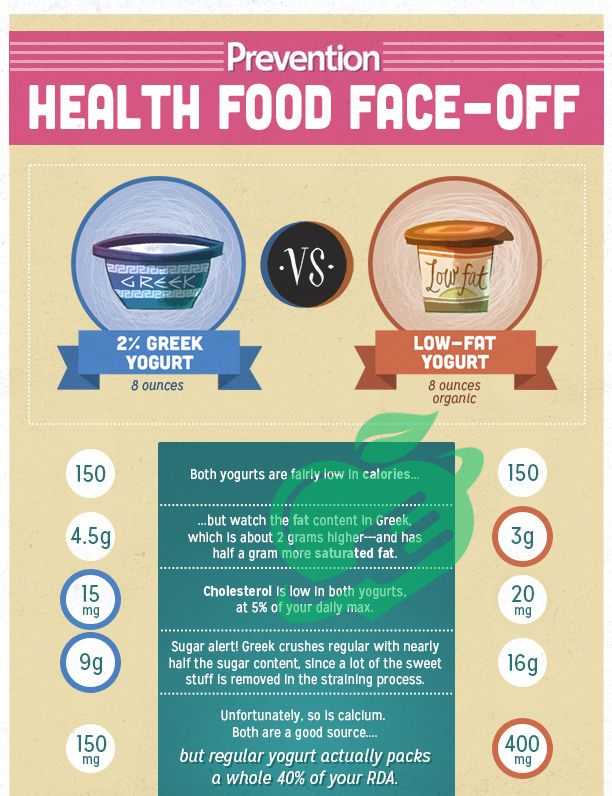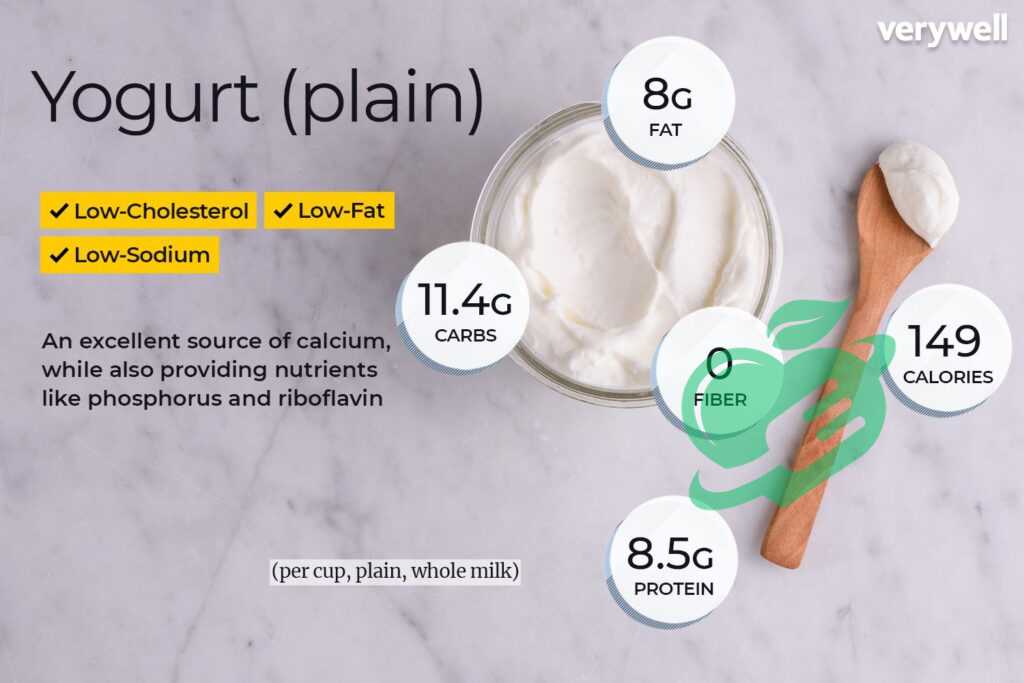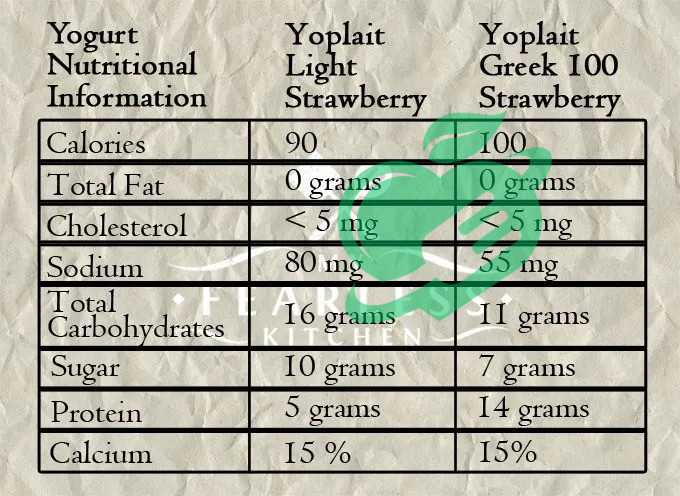
Nutritional Comparison
When choosing between Greek yogurt and regular yogurt, understanding their nutritional composition is crucial. Both types offer unique benefits, but they differ significantly in macronutrient content. Let’s take a closer look.
Macronutrient Composition
The macronutrient profile of these yogurts can dramatically affect your dietary choices. Here’s a quick comparison of the general macronutrient composition of both options:
| Macronutrient | Greek Yogurt (170g) | Regular Yogurt (170g) |
|---|---|---|
| Protein | 15g | 9g |
| Fat | 10g | 4g |
| Carbohydrates | 6g | 14g |
This table clearly illustrates that Greek yogurt packs a protein punch while also containing more fat. This composition makes it an excellent choice for those looking to increase their protein intake while managing their calorie consumption.
Protein Content
Greek yogurt is renowned for its high protein content. With about 15 grams of protein per serving, it can serve as a filling snack or component of a meal, especially for those engaging in strength training or looking to boost muscle synthesis.
- For example, a scoop of Greek yogurt can be a perfect addition to morning smoothies, helping you feel full longer while providing essential nutrients.
In contrast, regular yogurt contains about 9 grams of protein, which is still beneficial but significantly less. For individuals focusing on building muscle mass, Greek yogurt is undoubtedly the better option.
Fat Content
When it comes to fat content, Greek yogurt typically has a higher percentage of fat compared to regular yogurt.
- A standard serving of Greek yogurt can contain around 10 grams of fat, which includes both saturated and unsaturated fats.
- Regular yogurt, on the other hand, has about 4 grams of fat.
This difference in fat content can influence how these yogurts fit into various diets. While some might prefer Greek yogurt for its rich texture and added satisfaction, others may opt for regular yogurt to keep their dietary fat lower.
Sugar Content
Sugar content is another important consideration. Greek yogurt generally has less sugar, around 6 grams per serving, compared to 14 grams in regular yogurt.
- This lower sugar level makes Greek yogurt a favorable option for those watching their sugar intake, as it doesn’t contribute to blood sugar spikes.
In summary, understanding the nutritional differences between Greek and regular yogurt helps consumers make informed choices based on their dietary goals. Whether prioritizing protein, managing fat content, or monitoring sugar intake, both options have distinct advantages to consider. 1

Probiotic Content
Moving beyond the macro perspective, probiotics in yogurt are a significant factor that contributes to gut health. Understanding what probiotics are and how they differ between Greek and regular yogurt can help you make a more informed choice.
Definition of Probiotics
Probiotics are live microorganisms that offer health benefits when consumed in adequate amounts. Often referred to as “good” or “friendly” bacteria, they play a crucial role in maintaining a balanced gut microbiome. If you’ve ever felt the digestive benefits of eating yogurt after a heavy meal or antibiotic treatment, you experienced the power of probiotics in action. To put it simply, probiotics improve gut health by:
- Enhancing digestion
- Supporting immune function
- Reducing feelings of bloating or discomfort
It’s like introducing reinforcements to your digestive army!
Probiotic Strains in Greek Yogurt
Greek yogurt is particularly rich in probiotics, largely due to the fermentation process it undergoes. Common strains found in it include:
- Lactobacillus bulgaricus
- Streptococcus thermophilus
- Lactobacillus acidophilus
These strains are known for their robust effects on gut health and may even contribute to improved lactose digestion, which is a boon for those who are lactose intolerant. A personal favorite tactic is stirring Greek yogurt into a smoothie for an extra probiotic boost, feeling good about the deliciousness and health benefits in every sip! 1
Probiotic Strains in Regular Yogurt
Regular yogurt also boasts a variety of probiotic strains, although the composition can vary significantly between brands and types. Common strains include:
- Lactobacillus acidophilus
- Bifidobacterium bifidum
While it shares some beneficial strains with creamy Greek yogurt, regular yogurt tends to contain a wider variety of bacteria, which can aid in a variety of digestive functions. The choice between Greek and regular may come down to personal preference when it comes to texture and taste, but both offer health-promoting benefits. In conclusion, whether you choose Greek or regular, adding probiotics can elevate the nutritional value of these delicious treats. Pairing yogurt with different fruits or granola can enhance the experience even more, making it easy to reap the health benefits while enjoying the delicious flavors.

Health Benefits
After exploring the probiotic content of Greek and regular yogurt, it’s clear that both options contribute significantly to health. However, the benefits go beyond gut health, extending to various aspects of well-being. Here’s a closer look at the major health benefits these creamy delights offer.
Digestive Health
Both Greek and regular yogurt are champions of digestive health, thanks to their rich probiotic content. These beneficial bacteria help maintain a balanced gut microbiome, which can alleviate issues such as:
- Bloating
- Constipation
- Diarrhea
Imagine enjoying a refreshing bowl of yogurt after a heavy meal—it’s a common practice that many find soothing. For instance, incorporating yogurt into daily diets has been a game-changer for those with sensitive stomachs, making it a staple on grocery lists.
Read also: Thyroid Troubles? Find Relief with Effective Hypothyroidism Treatments
Weight Management
Greek yogurt, in particular, shines when it comes to weight management. With its higher protein content, it helps increase feelings of satiety, making it easier to resist those mid-afternoon snack cravings. Here’s how it can help:
- High protein = feeling full longer.
- Lower sugar levels (especially in Greek yogurt) reduce unnecessary calorie intake.
Picture swapping out sugary snacks for a serving of Greek yogurt topped with fruits or nuts. Not only does it taste good, but the added protein keeps you satisfied until your next meal, which can help maintain a healthy weight.
Nutrient Absorption
Yogurt is not only nutritious but also enhances nutrient absorption. The probiotics support the digestion of nutrients, making vitamins and minerals more accessible for your body to utilize.
- Key nutrient benefits include calcium, magnesium, and vitamins B12 and D.
Adding yogurt to meals can be advantageous, especially if you’re looking to maximize the benefits of other foods. A simple pairing might be yogurt with whole grains, activating better nutrient access. 2
Bone Health
Calcium, a key component in both Greek and regular yogurt, plays a vital role in bone health. Adequate calcium intake helps prevent bone-related issues like osteoporosis later in life.
- A typical serving of yogurt can provide around 15% of your daily calcium needs.
Think about that jug of yogurt sitting in your fridge—it’s not just for snacking; it’s a powerful ally in maintaining strong bones. Incorporating it into your diet regularly can have lasting benefits, especially as you age. In conclusion, from digestive health to weight management, nutrient absorption, and bone health, both Greek and regular yogurt offer numerous health benefits. Including these yogurts as part of a balanced diet can be a delicious way to support overall well-being.
Read also: Satisfy Your Cravings: 20 Healthy Snacks That Won’t Sabotage Your Diet.

Calcium Content
Having explored the various health benefits of Greek and regular yogurt, it’s now essential to highlight the role of calcium, a critical nutrient often found in these dairy products. Understanding the importance of calcium and how much it varies between yogurt types can help consumers make better dietary choices.
Importance of Calcium
Calcium is not just a mineral; it’s the building block of strong bones and teeth. Ensuring adequate calcium intake is vital for several reasons:
- Bone Strength: Calcium helps build and maintain bone density, reducing the risk of osteoporosis as we age.
- Muscle Function: It plays a crucial role in muscle contraction, which is especially important for athletes and active individuals.
- Nerve Transmission: Calcium aids in nerve impulses, ensuring smooth communication between the brain and body. 3
For many, yogurt becomes a go-to source of calcium. Incorporating calcium-rich foods into your diet is easier than it sounds—just think of that comforting bowl of yogurt after a long day.
Read also: Innovative Therapies for Treating Coronary Artery Disease (CAD)
Calcium Levels in Greek Yogurt
Greek yogurt is often praised for its high nutritional value, especially its calcium content. On average, one serving (about 170 grams) contains about 15% of the recommended daily intake of calcium. This can translate to about 150 mg of calcium per serving, depending on the brand and preparation method.
- Creamy and Calci-yummy: You might enjoy Greek yogurt in smoothies or as a base for dressings, adding both taste and a calcium boost.
While not as high as some cheeses, the calcium in Greek yogurt still offers significant benefits, making it an excellent choice for those seeking to strengthen their bones.
Calcium Levels in Regular Yogurt
Regular yogurt typically contains slightly higher calcium levels compared to its Greek counterpart. A standard serving (170g) can provide around 20% of your daily calcium needs—approximately 200-250 mg, again depending on the brand.
- Diverse Options: Regular yogurt can come in many flavors and varieties, which can cater to sweet cravings without compromising health. 3
Using regular yogurt in playful ways, like layered with granola and fruits, allows for nutrition to blend seamlessly into enjoyable snacks or meals. In conclusion, both Greek and regular yogurt serve as excellent calcium sources, playing an essential role in bone health and overall wellness. Including these two yogurt types into daily meals not only satisfies the taste buds but also supports long-term health goals.
Read also: What is ancient medicine?

Texture and Taste
Continuing the discussion on yogurt, the sensory experience—texture and taste—greatly influences consumer preference. Both Greek and regular yogurt have unique qualities that cater to diverse palates and culinary applications.
Creaminess
One of the main differences between Greek yogurt and regular yogurt is their texture. It is known for its thick, creamy texture, which is the result of a straining process that removes excess whey.
- Satisfying Indulgence: This creaminess makes Greek yogurt a hearty snack, perfect for those who enjoy a rich mouthfeel.
- Picture this: dipping fresh fruit into a bowl of Greek yogurt topped with honey. The luxurious texture creates an indulgent snack that feels special.
In contrast, regular yogurt has a lighter, more fluid consistency. This makes it easier to mix into smoothies or pour over cereal. The creaminess can differ based on brand; some regular yogurts aim for a thicker texture, but they still can’t quite match the richness of Greek yogurt.
Tartness
Taste-wise, the tartness of yogurt is another appealing attribute. Greek yogurt often has a more pronounced tang due to the fermentation process and higher milk content.
- Personal Preference: For those who appreciate bold flavors, the tartness can enhance the overall eating experience. A spoonful of Greek yogurt can genuinely awaken the taste buds!
Regular yogurt tends to have a milder flavor profile, appealing to individuals who prefer sweetness over tartness. This makes it a fantastic base for fruit-flavored varieties, as the sweetness can mask the tang. Personal favorites might include grabbing a vanilla-flavored regular yogurt and topping it with a handful of berries—delicious and less tart than Greek styles.
Versatility in Recipes
Both Greek and regular yogurt are incredibly versatile, making them popular ingredients in many recipes. This creamy spread shines in cooking and baking and has uses such as:
- Dips: Blending Greek yogurt with herbs and spices makes for a creamy, nutritious dip.
- Substitutes: It can replace sour cream in recipes, adding creaminess without excess fat.
Regular yogurt is also adaptable, perfect for:
- Smoothies: Its lighter texture blends well with fruits and greens.
- Dressings: It can lighten up salad dressings while maintaining creaminess. 4
In sum, whether you lean toward the creaminess and intense flavor of Greek yogurt or the lighter texture and sweeter taste of regular yogurt, both options provide diverse culinary avenues. Experimenting with recipes can lead to delightful discoveries that elevate homemade meals and snacks.
Read also: 5 important foods that protect you from depression.

Price Comparison
As we wrap up our exploration of yogurt’s attributes, it’s essential to consider the price. Understanding the cost differences between Greek and regular yogurt can help consumers make informed choices based on their budgets and preferences.
Cost of Greek Yogurt
Greek yogurt often comes with a premium price tag, reflecting its richer texture and higher protein content. On average, consumers can expect to pay between $1.00 and $2.00 per serving. However, the price can vary widely based on several factors:
- Brand: Popular brands may charge more due to reputation and flavor variety.
- Ingredients: Organic or specialty options (like lactose-free Greek yogurt) generally cost more.
- Size: Larger containers tend to offer better value per serving compared to single-serve cups.
For example, while a single cup of a leading brand of Greek yogurt might cost around $1.50, buying a family-sized package can bring the cost per serving down to around $0.75. This makes it a worthwhile investment for families looking to include it in their daily diet.
Cost of Regular Yogurt
Regular yogurt usually offers a more budget-friendly option, with prices ranging from $0.50 to $1.50 per serving. Similar to Greek yogurt, various factors influence these costs:
- Types: Flavored yogurts or those with added toppings can increase the price.
- Brands and Sales: Store brands often provide competitive pricing, and sales can make regular yogurt even more affordable.
For instance, you might find a store brand of regular yogurt for as little as $0.50 per 6-ounce cup, while well-known brands might be priced at around $1.00. Many grocery stores also frequently run promotions, which can help you stock up on your favorites at a lower cost. In summary, while Greek yogurt tends to be pricier due to its protein content and texture, regular yogurt remains a more budget-friendly choice without sacrificing nutrition. Personal budgeting can play a significant role in deciding which yogurt to buy, and keeping an eye out for sales can yield tasty savings for both types. Ultimately, including yogurt in your diet—regardless of the type—can be a delicious and beneficial move for overall health!
Read also: Dry Yogurt: Your New On-the-Go Essential.

Summary of Findings
Both Greek and regular yogurt provide a wealth of benefits, but they cater to slightly different preferences and nutritional needs. Here’s a quick recap:
- Nutritional Content: Greek yogurt is high in protein and lower in sugar, making it an excellent option for those focusing on muscle building or reducing sugar intake. Regular yogurt offers a broader range of flavors and slightly higher calcium content.
- Health Benefits: Both types promote digestive health, aid in weight management, enhance nutrient absorption, and contribute to bone health.
- Texture and Taste: Greek yogurt boasts a creamy richness and more pronounced tartness, while regular yogurt is lighter and can be sweeter, making it a crowd favorite for those seeking a milder taste.
- Cost Considerations: Greek yogurt may be pricier but offers nutritional value in terms of protein, while regular yogurt tends to be more budget-friendly and versatile.
In summary, both options are strong contenders in the yogurt category, providing unique advantages depending on an individual’s health goals and taste preferences.
Choosing the Right Option
When deciding between Greek and regular yogurt, consider a few factors:
- Personal Goals: Are you looking to boost protein intake or reduce sugar levels? Greek yogurt might be the answer. Alternatively, if you prefer a milder flavor and enjoy exploring different varieties, regular yogurt might suit you better.
- Meal Planning: Think about how you plan to use yogurt in your meals. If you’re making smoothies, regular yogurt’s lighter texture might be ideal. For toppings or dips, the richness of Greek yogurt can enhance your dish beautifully.
- Budget: Be mindful of how yogurt fits into your grocery budget. Don’t hesitate to mix and match! Perhaps stock up on regular yogurt for snacks while treating yourself to Greek yogurt for special recipes.
Follow us for more updates and breaking news, as we provide you with everything new.
- healthline ((↩))((↩))
- cabotcreamery ((↩))
- health ((↩))((↩))
- theguardian ((↩))




One Comment